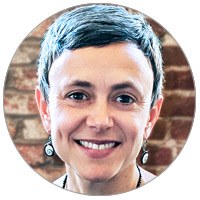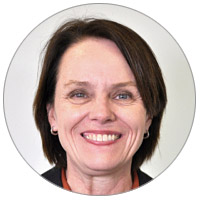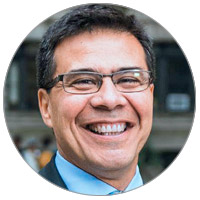Population Health
News
Integrating Social Needs Into Health Care Practice: Evidence and Barriers
Penn LDI Seminar Focuses on the Clinical Logistics of Addressing Social Determinants of Health
“In considering how the U.S. health care system should address the social determinants of health, a number of important questions arise,” said Rachel Werner, MD, PhD, as she opened LDI’s “Addressing Social Needs to Improve Health” virtual seminar on March 5. “Perhaps the biggest question is: Whose responsibility is it to do so? The health care sector? The social services sector? Another stakeholder or some combination of those?”

Werner, Executive Director of LDI and moderator of the event that brought together three top experts involved in the integration of social services into physical health care, went straight to the core of one of the field’s greatest quandaries.
The three panelists — Jorge Delva, PhD, MSW, Dean of the School of Social Work and Director of the Center for Innovation in Social Work & Health at Boston University; Caroline Fichtenberg, PhD, Managing Director of the Social Interventions Research and Evaluation Network (SIREN) at the University of California, San Francisco; and Kathleen Noonan, JD, Chief Executive Officer of the Camden Coalition of Healthcare Providers — agreed that inadequate nutrition, housing, transportation, and other social determinants are among the major drivers of poor health and premature mortality in marginalized communities. But how to change that?
Some community advocates have argued that hospitals and health care systems should expand their patient services to include social services that can assist with these needs. And some large health organizations, like UnitedHealth Group, Humana, and Kaiser, are experimenting with social care integration programs that link patients to social workers and social support resources.
Social workers
Social work is an academic discipline focused on supporting individuals and communities in getting their basic daily needs and achieving long-term wellbeing. Social workers function as advisors, information agents and navigators who are highly knowledgeable about the resources available through public health, public assistance, and other programs available to people living in under-resourced situations.
In theory, optimal integrated health and social care focused on the social determinants is a close-quarters collaborative partnership. While physicians and nurses are focused on a patient’s immediate medical condition, the social worker is simultaneously assessing factors like food insecurity, inadequate housing, homelessness, joblessness, transportation shortfalls, and other issues that directly contribute to ongoing health problems. The social worker is identifying ways to connect the patient to resources that can solve or mitigate issues in those areas, and is maintaining contact over time to monitor the situation’s progress. Together, the provider clinicians and social workers are treating the whole person in the context of that patient’s lived experience rather than just providing a medical treatment during a brief and information-sparse clinical encounter.
There are 650,000 social workers across the country, about half of whom are embedded in health care facilities of one kind or another. But, panelists noted, there is wide variation in the ways and degrees to which integration of social services into health services is actually being achieved across those settings. There is also wide variation in the amount of research evidence available about the overall integration process as well as its individual components.

Latest evidence
“One of the most common things happening in these programs is screening for social needs in the clinical setting,” said panelist Fichtenberg, who is a Research Scientist in the UCSF Department of Family and Community Medicine. “It’s one of the first ways to bring information about that part of patients’ lives into the clinical setting. It’s also one of the areas in which we have the most research so far — it found patients pretty acceptable to being asked about social risks in the clinical setting as long as it’s done in a way that doesn’t feel targeted or stereotyped.”
“Another area of activity being studied is the process of referring or navigating patients to internal or external social services,” Fichtenberg said. “The evidence is growing and indicates it’s possible to connect people to services but raises the question of who should be doing it, and what are the best ways to do that? One component that generated a lot of interest recently is off-the-shelf technologies that enable personnel to search for relevant services and then electronically refer patients to those. There’s been a huge uptake in this but not much evidence about how effective it can be.”
“Then, there’s the actual provision of the needed services from third-party services health systems can use,” continued Fichtenberg. “These include things like food pantries, medically-tailored meals, home-delivered meals, and medical-legal partnerships. There’s been really good evidence coming out on the benefits of these. Housing is another important area. The housing evidence is really complex and is still growing.”
“A current challenge in all this for the human services sector is that a lot of the work is driven primarily by health care priorities, as opposed to a blend of health care and human services priorities,” said Fichtenberg. “That can involve misaligned incentives. For example, the health care side focuses more on high-cost users, so there’s not as much focus on children. But social factors matter tremendously over the life course. Ensuring an environment in which children can thrive and develop appropriately is incredibly important to their health in the long run.”
Inadequate governance rules
Established in 2006 to bring an integrated system of medical and social services to a large population of health care super users, the Camden Coalition of Healthcare Providers uses care teams comprised of a licensed practical nurse, a social worker and a community health worker. As part of its goal of coordinating regional services for its patient panel in 2015, it created “Aunt Bertha,” an easily searchable online digital tool that has indexed social service support programs for food, housing, transit, health care, financial and legal services, education and jobs resources.

“We’re very focused on linking health and non-health providers and have been doing that for a long time” said Noonan, who is also an LDI Adjunct Senior Fellow. “It’s very hard and I’m not surprised the evidence is not in on that yet.”
“Some of the largest challenges for us,” Noonan said, “is the overall fragmentation of the system and the lack of governance rules about who is in charge. It gets very difficult when you have federal rules, state rules, local rules and don’t know who gets to tell who to do what. It’s something we need a lot more work in.”
“Another issue for us,” she continued, “is the lack of support for some patients in perpetuity. The system just loves a program that begins and ends, but some people need some help all the time. But we don’t really want to grapple with that because it goes against our idea that the system can fix people and then we’re done. However, our Housing First program is a much lighter touch intervention, but we check in with people at least once a month. They’ve graduated from our program, but we make sure that all is going OK. There are some people that just may need a light touch in an ongoing way.”
“A third issue is investment in primary care,” Noonan said. “When the ACA passed, we had starry eyes about the things we thought would come to be in primary care after that. But those never really came to be. Integration in primary care has not happened. I also think that while we talk about social determinants and health systems around things like food and transportation, we’re really missing the conversation around behavioral health and what hasn’t been invested in a place that I think is really closer to the health system’s interests than food or housing.”
Social workers’ integration struggles
Asked how close the field is to having true health care/social care partnerships, panelist Delva said, “Despite the health care world’s recent discovery that social workers play a key role in addressing social determinants of health, their role still remains poorly understood. Some tell me they’ve been working in institutions for 20 years and colleagues from another profession still scratch their heads about what exactly social workers do.”

“We’re far from integration in our profit-driven system because health care still operates in ways that value social worker services but can’t figure out how to get them paid within the existing reimbursement mechanisms. And the concern about social determinants of health is still new and not central to the mission of medical systems of care. In some places, it’s even perceived as a distraction from the original mission.”
“In too many cases, social work is used as a cost center rather than an essential part of care needed to ensure equitable and optimal health care outcomes. Yes, social workers’ potential has become obvious, but we’re not the most empowered personnel in the settings where we work. In too many cases, social workers are not staffed in a way that each patient will have access to a social worker.”
“In many of the settings where they are located, social workers play a real key role by bringing to the table a perspective that reminds us that the system in place has historically, purposely, and systematically enacted policies and programs that disenfranchised certain communities. Social workers help de-stigmatize and help people open their minds to the humanity of the individuals we’re working with.”
“Lastly, I have hope for the future, and the questions we’re discussing here today are very important, but they reflect an attempt to put bandaids on a fragmented health care system,” said Delva. “When I hear of health systems providing housing or legal care or food pantries — all important things that help meet a need — I still wonder ‘Why isn’t society providing those? Why is the burden falling on hospitals?’ The bottom line is: Why are we as a society not able to muster the political will and imagination to pursue policies and programs that keep people from going hungry, or not having housing or getting a quality education or receiving universal health care?”